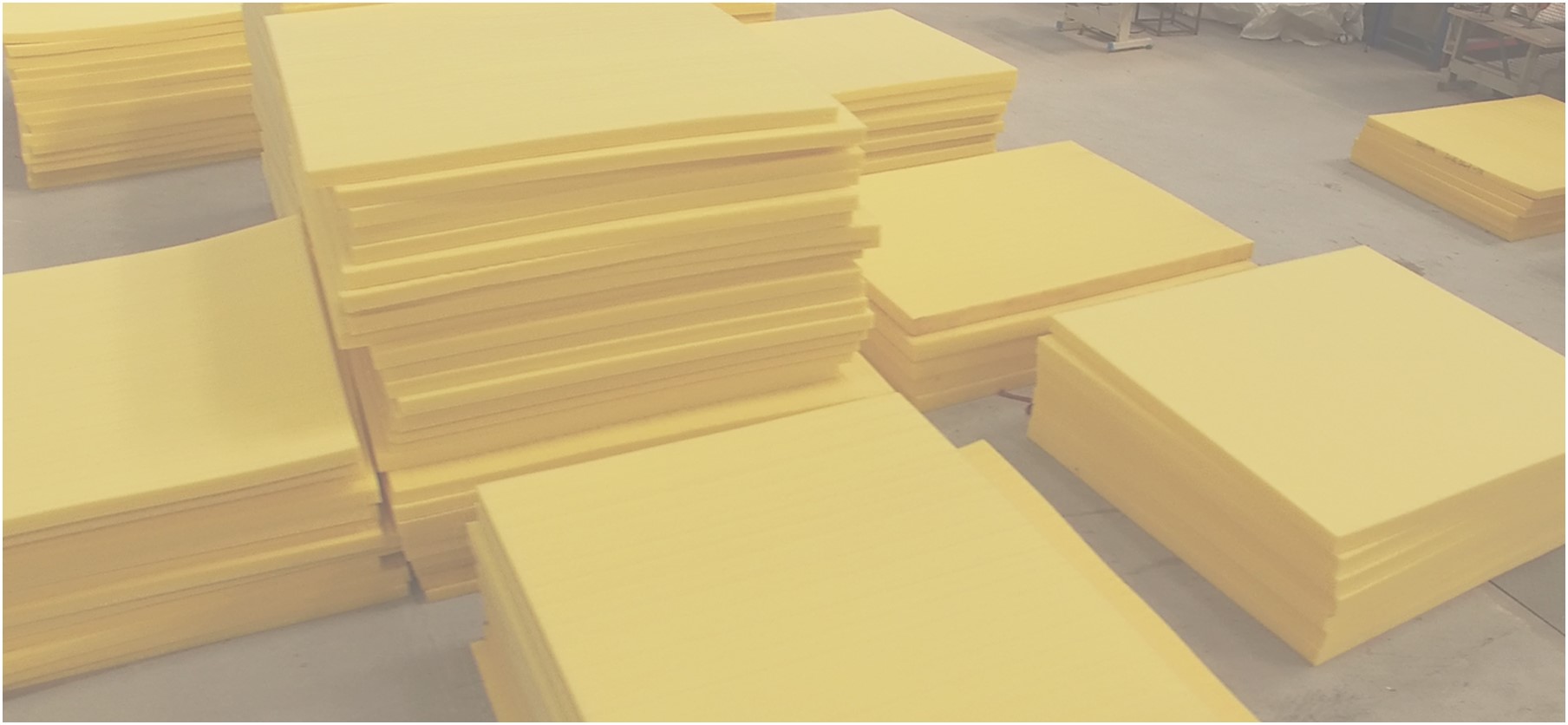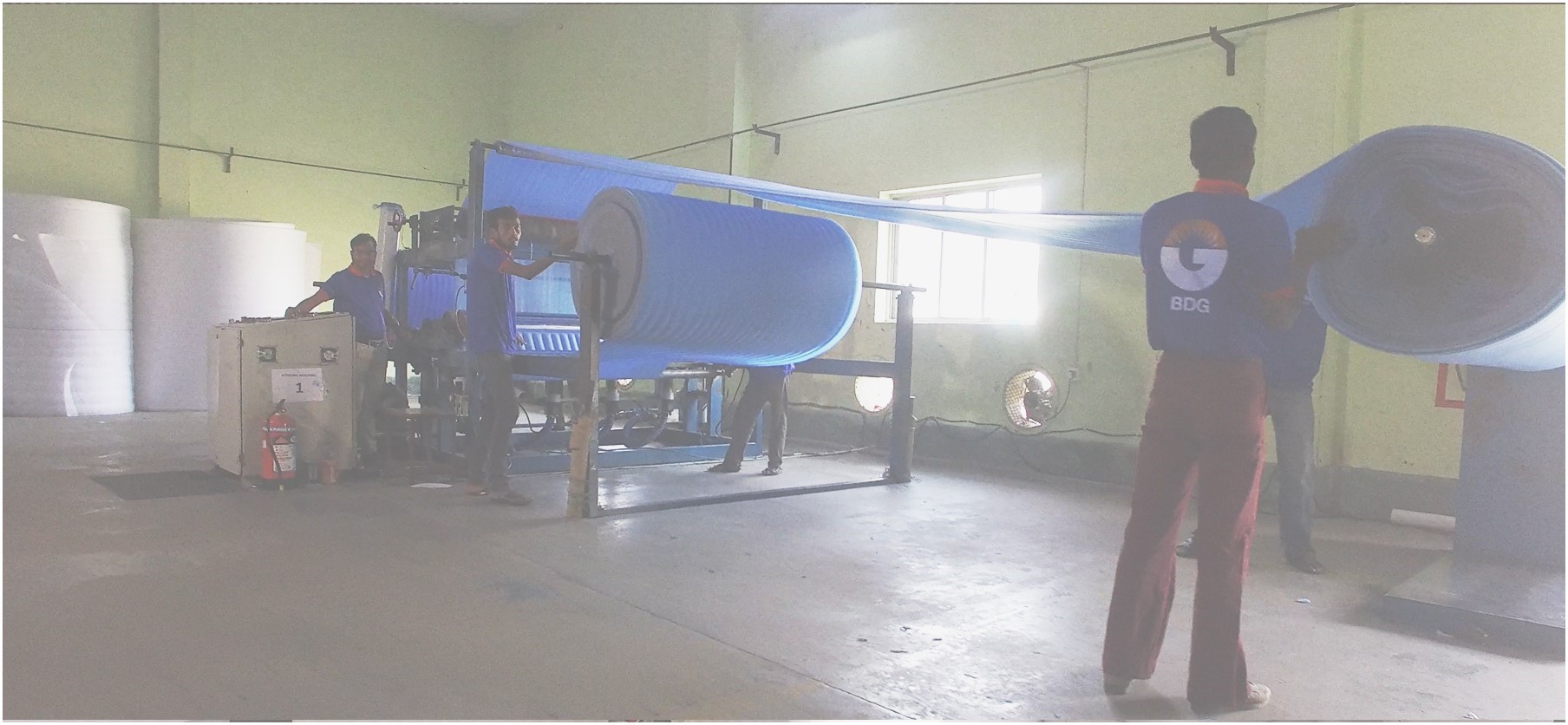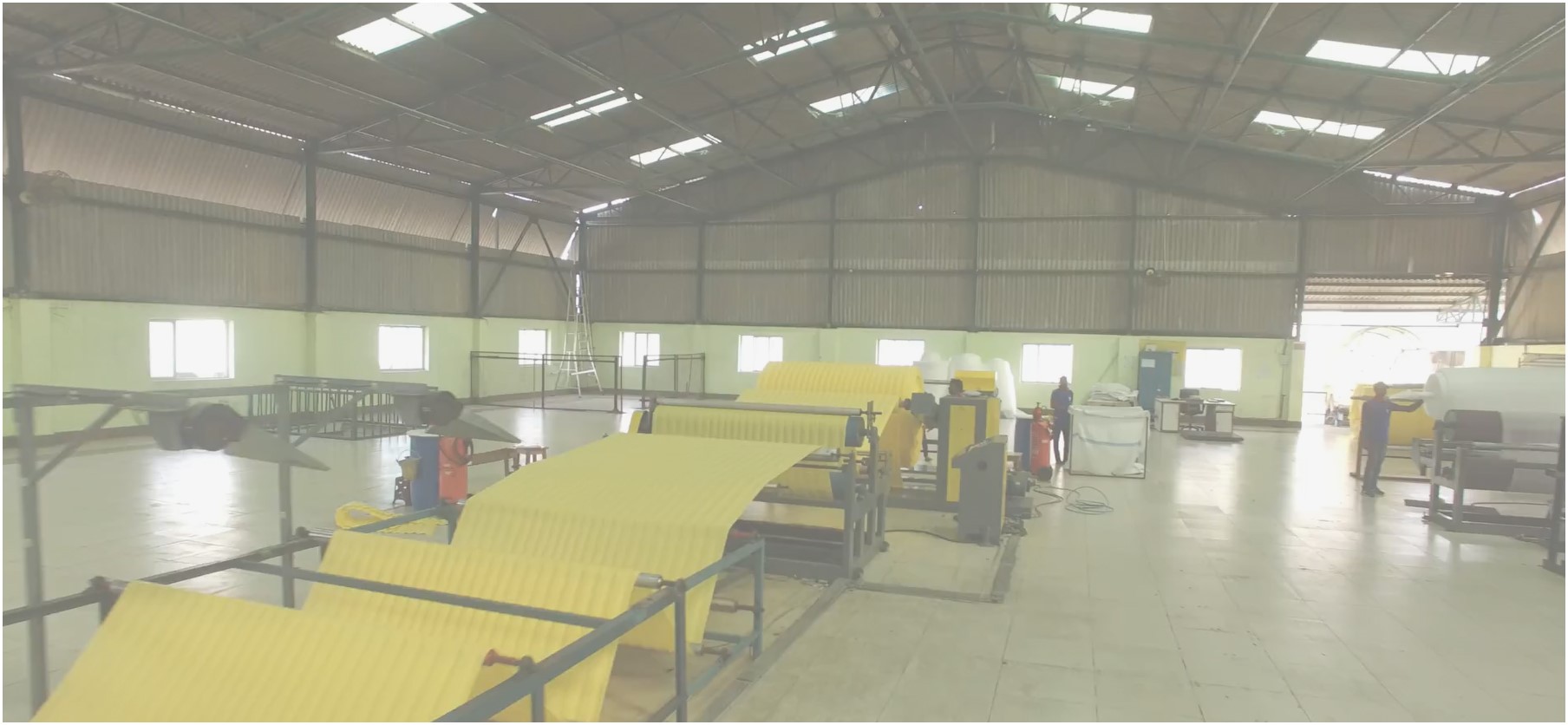Protective Packaging








EPE Foams Products
EPE (Expanded Polyethylene) foam is a petrochemical product & having versatile applications ranging from packaging for construction, automotive parts to sports goods, and protective covers to air-conditioning insulation etc.
EPE foam is manufactured through extrusion process. Heat lamination process is used to form a composite multi-layered structure with homogeneous bonding & taper free surface . EPE foam has a very fine and uniform microcellular structure.
BENEFITS /USAGES
-
Custom-fitting fabricated packaging for high value items produced in limited volumes.
-
Eliminates cost of making expensive moulds.
-
More economical than using EPS in many cases.
-
Can be tailored to match the shape, size or profile of any product, by using a simple hot air gun or knife.
-
Provide excellent cushioning against shocks, vibrations, abrasions.
-
Non-toxic, resistance to fungi bacteria & chemicals.
-
Combines resilience with flexibility.
-
Requires no special expertise to fabricate or use.
-
Electronic industries used as fitments for printers, computers, engineering industries, Handicraft Furniture, Medical Equipments, Artillery Box, etc.
SEGMENT WISE APPLICATIONS
-
Electronic / Electrical Based : Computer, X-ray, equipments & films, electronic equipments and components, audio/video equipments.
-
Fragile Based : Marble, Granites & Tiles, Glass & Glassware, Guages & Scientific instruments etc.
-
Insulation : A.C. insulation pads, A.C. ducting, Pipe insulation, Underdeck / Overdeck insulations etc.
-
Construction : Expansion joint filler, Water proofing of Terraces etc.
-
Marine : Life saving jackets, Life vests, Oil boom etc.
-
Sports : Judo /Wrestling mats, Yoga mats, Leg & thing guards etc.
-
House hold : Sleeping mattress, cushions, Sofa sets etc.
TECHNICAL SPECIFICATIONS
| No. | Property | Unit | Value | Remarks |
|---|---|---|---|---|
| 01 | Density | kg / mtr3 | 20-35 | As per ISO: 84502 |
| 02 | Tear Strength | kg / cm | up to 0.7 | As per ISO: 8067 |
| 03 | Tensile Strength | |||
| Transverse Direction | kg / cm2 | 1.5 – 3.5 | IS-7888 | |
| Machine Direction | kg / cm2 | 2.5 – 5.0 | -do- | |
| 04 | Elongation at Break | |||
| Transverse Direction | % | 50 – 70 | IS-7888 | |
| Machine Direction | % | 80 – 100 | -do- | |
| 05 | Compressive Strength at 10% | kg / cm2 | 0.08 – 0.20 | – |
| 06 | Water absorption 96 hours at 270C working % | 0.01 – 0.50 | – | – |
| 07 | Thermal conductivity at 500C mean temp. | K-cal / hr.m0C | 0.015 – 0.028 | As per ASTM C 177 |
EPE (Expanded Polyethylene Foam)
EPE (Expanded Polyethylene) foam is a product having versatile applications ranging from packaging for construction, automotive parts to sports goods, and protective covers to air-conditioning insulation etc. It has a very fine and uniform microcellular structure and is manufactured through an extrusion process. Heat lamination process is used to form a composite multi-layered structure with homogeneous bonding & taper free surface.
This foam is used in a plethora of applications including insulation panels, gaskets, flexible foam seating, and rigid foam insulation panels. The foam roll has an added advantage of withstanding shock, jerks, and tough conditions which makes it last for an extended period of time.
FEATURES
-
Flexible: Flexibility than most other alternatives, EPE Foam is light in weight and wraps around products with ease offering maximum protection.
-
Excellent Cushioning: Its cellular structure makes it highly shock-absorbent and provides an excellent cushioning for delicate objects making it durable for all packaging needs.
-
Resilient: EPE Foam regains its shape after shock. It is fracture, shatter and crumble proof and is resistant to external stresses.
-
Abrasive Resistant: Its soft texture gives complete protection against abrasive marks or scratches during transportation. This makes way for its usage in the transportation industry too.
-
Chemical Resistant: It is inert to most corrosive chemicals such as acids, alkalies and other chemical solvents and retains its original texture.
-
Moisture Resistant: Because it is virtually impermeable, the amount of water EPE Foam absorbs is negligible. This property allows the usage in packaging industry where protection from water is essential.
-
Static Resistant: Unlike other packaging material EPE Foam does not attract dust from the atmosphere due to its inherent anti-static properties. Specially made anti-static grades (pink colour) are also available. This is dust-free and needs less maintenance.
-
Thermal Insulation: EPE Foam has proved to be a superior insulating material because of its extremely low thermal conductivity and moisture absorbent properties. It has a high weight to strength ratio and high thermal resistance.
-
Non Toxic & Odourless: A safe product for packaging of food stuff. Resists fungi and mold growth and serves as an excellent product to safeguard perishable food.
-
Easy to Fabricate: EPE Foam can be melted and fabricated into desired shapes and structures. No expensive molds are required.
-
Light Weight Yet Tough: Its lightweight saves cost of handling and transportation, at the same time it is tough and serves the purpose.
-
CFC-free: It is also Chlorofluorocarbons (CFC) free and therefore environment friendly.
-
Effective Temperature Range: Without affecting its properties, EPE Foam can be used in temperatures ranging from – 40 degree to 70 degrees.
-
Variety of Colours: EPE Foam is available in a wide range of colours.
-
Wide Product Range: EPE Foam is available in a wide range of rolls, planks, reinforced sheets, fabricated products, to suit specific requirements.
APPLICATIONS
-
Ceramic products and sanitary wares: EPE is used because it provides protection from scratches and external damage.
-
Electronic Equipment: It is used for impact and shock absorption, vibration dampening, and surface protection.
-
Handicrafts
-
Submersible Pumps
-
Insulation: EPE rolls and insu-tubes are widely used for insulation of windows, split AC, air handling units and AC ducting, industrial chillers, cold storage, refrigerated vans, industrial refrigerators, cold water pipes and high altitude drinking water pipe insulation.
-
Automobiles: It is used for roof tops, engines, bonnets, driver cabin insulation, door panels, seat linings, floor mats, carpet underlays, upholstery, sun visors and AC insulation.
-
Marine
-
Construction
-
Jewelry Packaging
-
Toys & Novelties
-
Mattress: This product can be used as a substitute for coir.
-
Packaging: Used as a substitute for Thermocol packaging in televisions, computers, refrigerators, washing machines, electronic equipment, glassware, ceramics, polyester yarn/film, handicrafts, printers, UPS, currency teller machines, diagnostic kits, surgical equipment and other fragile and delicate products. In electronic equipment, it is used as corner pads, buffers, encapsulation blocks, ribs, support pads, adhesive backed sheets and much more.
-
Fabrication
-
Buffers
-
Mandap decoration
-
Furniture Industry
-
Roofing
-
Carpet & Mats
-
Sports : It is used in wrestling, judo, gymnastics, taekwondo, jogging exercise mats, leg and thigh guards, arm/elbow/shoulder pads, helmets, sleeping bags, ski belts, life saving jackets and glove and costume insulation.
-
All types of Bags
-
Shoes
-
Flooring
-
Cold Storage
-
Tent House
-
Bus seats
Polyurethane (PU Foam)
Commercial PU Foam that we are offering is unmatched in terms of quality and performance. The PU foam is used widely in high-resiliency flexible foam seating, insulation panels, and packaging. It is used widely in the automobile industry, and packaging works, among others. This foam is easy to use and does not degrade in quality or performance due to heavy loads, heat, and jerks.
Polyurethane bonds have great adhesion strength and that makes it bond extremely well to the surfaces applied. Flexible Polyurethane Foams are used mainly for assembly of doors and windows, infilling applications, sound and heat insulations, waterproof barriers and insulation against fire.
FEATURES
-
Resilience: PU foams have good abrasion resistance. Their lower resiliency and higher energy absorbency also make them more suitable for use in packaging applications.
-
Solvent resistance: Polyurethane foams are known for being resistant to a wide range of solvents and so are particularly used in dry cleaning solvents.
-
Antibacterial resistance: Polyurethane foams perform quite well in fungal and microbial growth. Bacteria struggle to adhere to the polymer surface, making growth more difficult. So, they are used in medical and hygiene applications.
-
Yellowing and discoloration: To prevent the discolouration of polyurethane foam, and enhance its UV resistance, light protecting agents and stabilizers are added at the manufacturing stage to prevent yellowish discoloration.
APPLICATIONS
-
Mattresses: It is often used as an upper comfort layer in innerspring mattresses.
-
Furniture: Flexible polyurethane foam is most commonly used as a cushioning material in upholstered furniture. Some are functional; others are aesthetic.
-
Automotive interiors: The walls and ceiling (not just the insulation) in the USA, are built out of polyurethane foam.
-
Carpet underlay and packaging
-
Soft flexible foam toys: It serves as a filling and quilting material.
-
Footwear: It is used because of its lightness and high resistance. It also provides a cushioning effect with thermal insulation and slip resistance.
-
Textiles, fiber, and apparel: A thin film of polyurethane foam finish is added to a polyester weave to create polyurethane laminate (PUL), which is used for its waterproof and windproof properties in outerwear, and shower curtains. Polyurethane is used in some cutting-edge swimsuits to provide buoyancy for competitive swimmers.
-
Kitchen and bathroom products: Polyurethane foam is used in making sponges for kitchen and bathroom cleaning.
-
Automobiles: Flexible and semi-flexible polyurethane foams are used for interior components such as in seats, armrests, headrests, roof liners, dashboards and instrument panels.
Rebonded Foam
Rebonded foam, otherwise called recon or chip foam, is made from leftovers of other foam. This is a recycled foam where the foam scraps are mixed with liquid polyurethane. This binds them and compresses them into a block. This foam has an open-cell structure and is known for its firm and durable properties. It is the most eco-friendly and one of the most versatile versions of foam. This is used in mattresses, carpet padding, weight equipment, motorcycle seats, and other covered padding.
FEATURES
-
Very high density: Rebond foam is well known for its remarkable density. It has a density of 6 – 8 pounds per cubic foot. But this could go as high as 12 or 15 lb per cubic foot.
-
Higher ILD (Indentation Load Deflection): A higher ILD implies a firmer foam than that of a lower ILD. On average Rebond foam has an ILD of 7.0 pounds.
-
Firm and supportive: Rebonded firm offers great support because of its firmness.
-
Tear resistance: It is resistant to wear and tear and is used in the packaging industry.
-
Sound and shock absorbent: Provides sound insulation and shock absorption.
-
High durability and longevity: This foam is durable and has a greater longevity.
-
Versatile: Because of its ease of manipulation, this foam is used in various industries like packaging industry, carpet padding, wheelchair seats, etc.
APPLICATIONS
-
Mattresses: It is used as an upper comfort layer in innerspring mattresses.
-
House furniture: Serves as a great substitute to expensive beanbags.
-
General usage: Serves well for exercise mats, gym mats, massage tables and sofa.
-
Carpet padding and cushioning: Its ease of usage makes it a versatile foam for carpet padding and cushioning.

